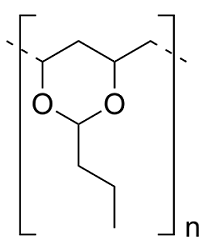Polyvinyl Butyral

Product Description
Polyvinyl butyral (PVB), a resin commonly used for its adhesive and film-forming properties, finds various industrial applications owing to its unique characteristics.
Product:
Polyvinyl Butyral
CAS:
63148-65-2
Synonym:
Vinyl butyral polymers; Vinyl acetal polymers; Poly[(2-propyl-1,3-dioxane-4,6-diyl)methylene]
Structure:

Typical Characteristics
Appearance
White to off-white powder
Density
1.08 g/cm3
Melting point
165-185 °C
Molecular Weight
40000-120000
Odor
Odorless
Purity
98%
Refractive index
1.485
Uses, Applications & Markets
Key applications
get a quote
We Offer Polyvinyl Butyral
in various grades
A few of the grades available are listed below:



Polyvinyl Butyral used in many
industry applications
Polyvinyl butyral (PVB), a resin commonly used for its adhesive and film-forming properties, finds various industrial applications owing to its unique characteristics. Here's a list of some of its industrial uses:
- Laminated Safety Glass: PVB is widely used in the production of laminated safety glass for automotive and architectural applications. It provides excellent adhesion between glass layers, enhancing impact resistance and safety.
- Coatings and Paints: In the coatings and paints industry, PVB is used as a binder and film-forming agent, offering excellent adhesion, flexibility, and toughness to coatings.
- Solar Panels: PVB is employed in the encapsulation of solar panels, providing protection and stability to the photovoltaic cells, enhancing the durability and performance of the panels.
- Adhesives: PVB is used in the formulation of adhesives, especially in the production of high-performance adhesives that require strong bonding and flexibility.
- Printing Inks: PVB is used in the production of printing inks, providing excellent adhesion and flexibility to the printed materials, especially in packaging applications.
- Protective Films: PVB is used to manufacture protective films for various applications, offering excellent clarity, adhesion, and impact resistance.
- Composite Materials: PVB is used as a matrix resin in composite materials, providing enhanced mechanical properties and stability to the composites.
- Electronics: PVB is used in the electronics industry for encapsulation and protection of electronic components, offering good electrical insulation and mechanical stability.
- Packaging: PVB is used in packaging applications where clarity, flexibility, and durability are required, such as in the production of high-quality packaging films.
- Textiles: PVB is used in the textile industry for coating fabrics, providing water resistance, flexibility, and durability to the textiles.